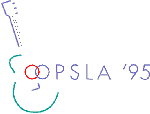 Business Object Design and Implementation Workshop
Business Object Design and Implementation Workshop
 Business Object Design and Implementation Workshop
Business Object Design and Implementation Workshop
 Position Paper
Position Paper The REA Accounting Model Framework
The REA Accounting Model Framework
 William E. McCarthy (21277WEM@MSU.EDU)
William E. McCarthy (21277WEM@MSU.EDU)  Organization
Organization
 Date/Place: 16 October 1995/Austin, TX
Date/Place: 16 October 1995/Austin, TX
In the search for semantically-tight and commonly-reusable business objects, little attention has been paid by the object standard setting bodies to enterprise architectures offered by people in specific business domains like accounting or microeconomics. We offer one such framework for discussion -- the REA accounting model.
The basic semantic specifications of the REA model were derived with the methods of data abstraction (aggregation, generalization, classification) from both existing practices and accounting theories. Its initial specification was given in an article in THE ACCOUNTING REVIEW, the leading worldwide journal in the accounting domain [McCarthy, 1982]. Since that time, the model has been fortified with additional definitions and extensions, implemented in a variety of database and knowledge-based environments, and tested empirically [Geerts and McCarthy, 1995]. At present, its concepts have been embedded in the GENEVA (GENeralized EVents Architecture) practice of Price-Waterhouse and in the Financial Data Warehouse Project of IBM-Japan. In its uncompromised (or epistemologically adequate) form, an REA model views the enterprise as a series of value-added processes, each of which contains (at the abstraction level deemed appropriate for a particular enterprise) a stereotypical object constellation with eight entities and seven relationships. We estimate that an accountability infrastructure built in object-oriented form by repeated use of this process model could account for well over half of the data definitions needed in a typical corporate enterprise.
Some of the open workshop questions that have REA implications are these:
We use microeconomic primitives starting with the definition of an "economic resource" (something which is scarce, has economic utility, and is under the control of the enterprise).
We answer in the affirmative and offer a full process model of economic phenomena that equates to a Porter-type value chain.
As instances of the general classes of economic phenomena such as economic resources, economic events, economic agents, stock-flow relationships, control relationships, and duality relationships.
We have developed a methodology for judging the "semantic expressiveness" of a given set of legacy implementations (in other words, how much compromising went on during its analysis and design). These measures show where the uncompromised object-oriented structures and accounting file systems for instance could possibly be coupled.
We propose using existing accounting concepts of internal control (specified semantically) and integrating them with the REA accountability infrastructure (that is, the enterprise object architecture).
We suspect that many of the semantic business frameworks that other workshop participants might be using would bear strong resemblances to the REA model.
In the workshop, we hope that communication between the computer science oriented research teams and our own accounting group could be enhanced. In that way, any of the standardization efforts that result could resemble strongly the national charts of accounts classification systems that exist in countries like France or Belgium (except that object technology would make them far, far more flexible). They would become business ontologies into which individual enterprise data could be categorized, thus greatly facilitating distribution, comparison, and use of that data across companies and across countries.
W.E. McCarthy (1982) "The REA Accounting Model: A Generalized Framework for ccounting Systems in a Shared Data Environment" THE ACCOUNTING REVIEW, July 982, pp. 554-78.
G. Geerts and W.E. McCarthy (1995) "Use of an Accounting Object Infrastructure for Knowledge-Based Enterprise Models" paper submittted to IEEE EXPERT (special issue on enterprise modeling), August 1995 (working paper available).
 Business Object Design and Implementation
Business Object Design and Implementation